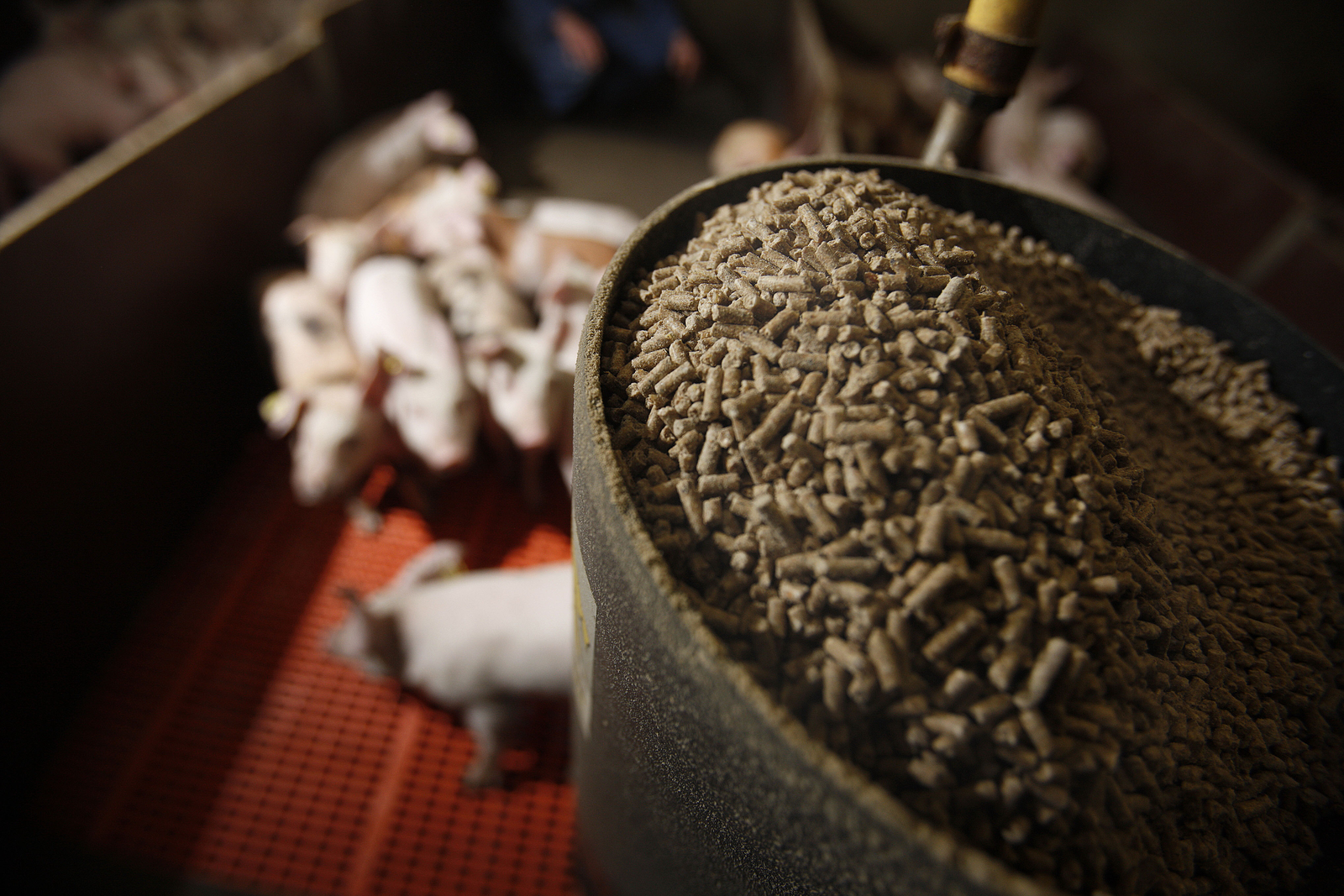Four ways to optimise performance

To make sure animals perform well ?and remain healthy, a pathogen free environment ?in combination with a strong gut health is key. Organic acids have been proven to play a ?significant role in this.
By Yvonne van der Horst, technical
manager Health & Preservation,
Selko, the Netherlands
Modern farming conditions pose serious pressure on reaching the highest production performance potential of animals. In this stressful situation, feed contamination, an immature gut flora in young animals and a high stocking density can suppress the ability of the animal to maintain a healthy status and high production performance. Organic acids are known to be effective in improving feed hygiene and as such can support intestinal health. An integrated approach of organic acids combined with other types of feed additives provides four steering mechanisms for preserving feed materials and supporting intestinal health in farm animals in order to cope with the challenges and to achieve optimal production performance.
Prevent bacterial intake
A first important steering mechanism is the prevention of bacterial intake. Acidifiers such as organic acids reduce diet pH, creating unfavourable conditions for microbial growth in feed and drinking water. This lowers microbial counts in feed and water and in turn reduces uptake of microbes by the animals. It is known that a combination of organic acids applied in feed or drinking water provides a synergistic effect on a broad spectrum microbial level. Formic acid is an attractive acidifier with the lowest minimum inhibitory concentration (MIC) against a list of Gram negative and Gram positive bacteria in comparison with other organic acids. Test results on feed and water samples collected over several years in the Selko Laboratory have revealed that formic and acetic acid are very effective in reducing Salmonella and E. coli. Sorbic and benzoic acid show the same efficacy, but these acids are only available as dry products which are less easy dissolved in an acid blend. Propionic acid is less effective against E. coli and Salmonella, however, it has the highest efficacy against moulds. In vitro trial results have shown that a synergistic mixture of formic and acetic acid is most effective in inhibiting growth of E. coli and Salmonella both at the low concentration of 0.5kg/ton and at 1.5kg/ton (Figure 1). Despite the reduced microbial count in feed and water, after addition of organic acids some microbes will survive and be ingested by the animal. Naturally, in monogastrics the stomach pH is low, in order to impair survival of these ingested microbes. During intake of feed the pH in the stomach will rise, providing more favourable conditions for microbial growth. Organic acids will reduce stomach pH in the presence of feed, thereby supporting the natural barrier against bacteria. Moreover, proteolytic enzymes are activated at a low pH value and will improve digestion.
Microbiota management
A second important mechanism to optimise performance and health is proper management of the microbiota. Density and diversity of the intestinal microbial population increases from the upper towards the lower intestinal tract. The upper part of the small intestine of pigs and poultry is dominated by gram-positive bacteria (Richards et al 2005). The cell wall of gram-positive bacteria has a thicker peptidoglycan layer in comparison with Gram negative bacteria which makes this type of bacteria more acid tolerant. Medium chain fatty acids (MCFA) are able to destabilise the peptidoglycan layer of Gram positive bacteria, making it permeable for organic acid molecules to enter. Moreover, MCFA reduce respiratory capacity of bacterial cells resulting in reduced proliferation and cell death (Kabala and Marshall, 2005). Skrivanova et al (2006) showed with an MIC test, that from the tested range of fatty acids C2 – C18, lauric (C12) and myristic acid (C14) have the highest activity against Clostridium Perfringens. Laboratory test results showed that a synergistic blend of organic acids and MCFA has the highest log reduction capacity of both Gram positive and Gram negative bacteria compared to organic acids or MCFA alone (Figure 2). Furthermore, it has the lowest impact on the favourable Lactobacilli. Therefore MCFA are combined with organic acids in order to expand the spectrum of activity and support maintenance of a healthy microbial balance. MCFA are digested and absorbed in the upper intestinal tract of monogastrics. However, as we know that the density and diversity of microbiota increases further down the intestine, also in the lower intestine microbial balance support is important. Esterified fatty acids are broken down in the lower part of the small intestine. This results in available fatty acids in this part of the gut, which can optimise the microbiota balance in the lower gut.
Buffered acid blends
Blends of organic acids used as feed additives are often buffered to make them less sensitive to changes in pH compared to non-buffered acids. These acid blends with stable pH are less corrosive and therefore safer for users. Figure 3 shows that the pH of an ammonium buffered solution is lower and more stable compared to sodium- or calcium buffered acids, proving that ammonium is a very effective buffering agent. During production of ammoniumformate, the chemical reaction of formic acid and ammonium generates a high temperature, causing the formation of the toxic product formamide. Selko Feed Additives is using reactors in her factory to control the temperature during reaction, for a safe and efficient production of (partially) buffered acid blends. Buffering agent ammonium has an additional effect in the upper intestinal tract. As the pKa of ammonium is relatively high (9.25), the ammonium salts will remain intact in the low pH region of the stomach and will not be neutralised by pancreatic juices. They will start dissociating only in high pH regions of the small intestine. When the ammonium starts to release part of its protons the acid becomes available thereby stabilising microbiota in the upper intestinal tract. Attachment of Salmonella to the intestinal epithelium is an important step in proliferation and colonisation in food producing animals. Inhibition of attachment therefore provides an additional barrier for Salmonella to colonise. Specific plant extracts are known to disturb the adhesion mechanism of Salmonella to the intestinal wall, supporting the animal in maintaining a healthy intestinal microflora.
Supporting gut barrier
An optimal functioning gut barrier is essential for animal health and performance and can therefore be considered as the third mechanism to optimise performance. Impaired integrity of the gut wall can lead to reduced nutrient uptake and higher exposure of animals to pathogens and toxins. Target release acids or esters of fatty acids are released in the lower small intestine. A trial done by Selko Feed Additives and Nutreco R&D revealed that the supplementation of broiler diets with a blend of target release acids and phenolic compounds alters tight junction protein expression in the duodenum, indicating that it supports a quick regeneration and restoration of tight junctions under stress conditions. Another trial demonstrated that villus height and crypt depth increased when the same blend was added to diets of piglets exposed to heat stress. These findings indicate that target release acids and phenolic compounds play an important role in maintaining a healthy gut wall with a strong intestinal barrier and optimal absorption of nutrients.
Strong immune system
The combination of stable intestinal microbiota, healthy gut wall and immune system play an important role in the natural mechanisms of animals against a variety of enteric pathogens and can be considered the fourth steering mechanism. The specific plant extracts which are used as feed additives to inhibit Salmonella adhesion, also positively influence the intestinal immune system. Research has proven that chickens provided with these plant extracts have increased IgA production and improved clearance of Salmonella enteritidis (Ibuki et al 2010).
Integrated approach
Maintaining a healthy intestinal status and therefore highly performing animals goes beyond managing feed hygiene alone. After intake of safe feed there are multiple aspects which challenge optimal feed efficiency. Selko Feed Additives combines the positive effects of organic acids and additional ingredients in her products to increase the benefits for the animal in maintaining a healthy intestinal tract. This integrated approach (Figure 4) contributes to a healthy status throughout the complete intestine and to more profitable performance.
References are available on request.
[Source: AllAboutFeed magazine Vol 22 nr 5, 2014]
Join 26,000+ subscribers
Subscribe to our newsletter to stay updated about all the need-to-know content in the feed sector, three times a week. Beheer
Beheer









 WP Admin
WP Admin  Bewerk bericht
Bewerk bericht